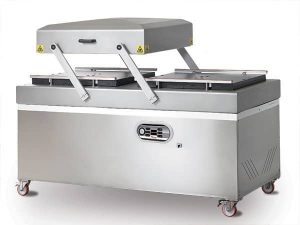 Order
Order
Oxygen changes the chemical composition of the product: during the oxidation process, its structure, color and odor change, vitamins and minerals are destroyed. Airborne aerobic bacteria and fungal spores penetrate into the food, and their rapid proliferation leads to spoilage.

Fresh vegetables, fruits, herbs, rennet cheeses have metabolic activity, therefore, for proper storage, they need free gas exchange of oxygen and carbon dioxide. They are stored in gas-permeable packaging – vacuum is not suitable for them.
Ready-made hot meals and semi-finished products, cold dishes, meat, poultry, fish, dairy products, soups, cereals, sauces and other perishable culinary products, on the contrary, do not need gas exchange, so they are placed in a barrier bag from which air is pumped out. In the absence of oxygen, the products do not oxidize, and the harmful microflora stops developing.
The shelf life in vacuum packaging increases by 2-2.5 times and depends on the temperature and type of product. However, there is a problem – vacuum sealers cannot create an absolute vacuum in the bag, ideally, its value reaches 99.98%. The remaining 0.02% allows oxidation and, as a result, the growth of bacteria if the product is not stored correctly.
Gaseous packaging technology comes to the rescue. During the evacuation process, an inert gas, such as food carbon dioxide, displaces 100% oxygen from the bag, making the storage of the product completely safe.
The shelf life in a vacuum package extends the shelf life of food by ~ 5 times.
The table shows the approximate shelf life in vacuum packaging, subject to temperature conditions.
| Product |
Shelf life under normal conditions |
Shelf life in vacuum packaging |
|
Raw foods when stored in the refrigerator (t= 5 ± 2 °C):
|
| Beef |
3-4 days |
8-9 days |
| Veal, pork, lamb, poultry |
2-3 days |
6-9 days |
| Fish |
1-2 days |
4-5 days |
| wildfowl |
2-3 days |
5-7 days |
| Sausages (whole sticks) |
7-15 days |
25-40 days |
| Sausages (slicing) |
4-6 days |
20-25 days |
| Soft cheese (fresh) |
5-7 days |
14-20 days |
| Hard cheese (infused) |
15-20 days |
25-60 days |
| Vegetables |
1-3 days |
7-10 days |
| Fruits |
5-7 days |
14-20 days |
| Cooked foods when stored in the refrigerator (t= 5 ± 2 °C): |
| Soups |
2-3 days |
8-10 days |
| Pasta and rice |
2-3 days |
6-8 days |
| Meat |
3-5 days |
10-15 days |
| Cakes and desserts |
2-3 days |
6-8 days |
| Frozen foods stored in the freezer (t= -18 ± 2 °C): |
| Meat |
4-6 months |
15-20 months |
| Fish |
3-4 months |
10-12 months |
| Vegetables and fruits |
8-10 months |
18-24 months |
| Dry food – storage at room temperature (t= 25 ± 2 °C): |
| Bread |
1-2 days |
12 months |
| Cookies |
10 days |
12 months |
| Pasta, rice and cereals |
5-6 months |
12 months |
| Flour |
4-5 months |
12 months |
| Dried fruits |
3-4 months |
12 months |
| Ground coffee |
2-3 months |
12 months |
| Tea |
5-6 months |
12 months |
| Milk Powder |
1-2 months |
12 months |
All of the above parameters are indicative and directly depend on the original quality and freshness of the product and on the integrity of the package.
In addition to increasing the shelf life of products, vacuum packaging has several other advantages:
- high profitability – savings on the cost of the package in comparison with other types of packaging materials (glass, sheet metal) and on areas (warehouse and transport) due to compact storage up to 50%;
- light weight and compactness of the package – the weight of the package is only a few percent of the mass of the product, the package itself during storage takes up little space in the warehouse;
- reliability – a high-quality bag does not break, does not burst, does not break, withstands high external pressure, in order to pierce or cut it, you need to make special efforts.




